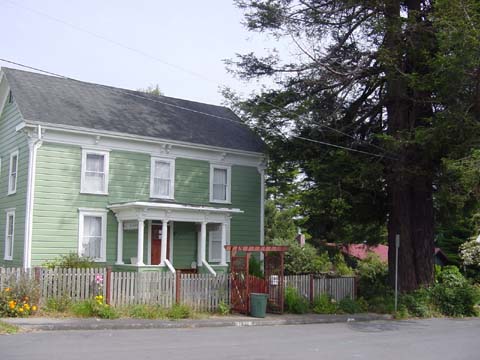- Created By: Site Admin
- Created: March 17, 2023 6:04 pm
- Updated: March 17, 2023 6:07 pm

Built in 1884 at the northwest corner of 10th and D Streets, this side-gable house was moved to its present site in 1971 because of freeway expansion. Cornice returns, decorative corner boards, and brackets on the wide frieze band and porch provide the ornamental detail to this settlement architecture. The colonial-style porch was added in 1906, when that was a popular thing to do to older homes.
Our enterprising citizens George Boscow and son are doing a good deal toward the improvement of the easter portion of Arcata heretofore called Stump Town. They have erected a large and commodious two-story frame on block 204 on the eastern side of Tracy’s gulch. (Daily Humboldt Standard, April 24, 1884)
Arcata’s first commercial logging and milling of redwoods took place along this creek in 1853 when Titlow, Dunbar and McLain built a steam-run sawmill and produced the lumber used in the community’s first buildings. Century-old redwoods of a size previously unknown to arriving woodsmen covered this East Arcata area. The giant trees were felled by teams of men standing on platforms inserted into the trees and often sawed for days to bring them down. Oxen moved the fallen logs to water courses or railroads of tree-pole tracks and horse “locomotives.” The massive stumps left behind gave this part of town a reputation and a name—Stump town—which persisted into the 20th century. Before it became a conduit for logs and had its outlet to the bay changed, little Gannon Creek was the home of coastal cutthroat trout, known locally back then as “speckled beauties,” and spawning steelhead and silver salmon.

Built in 1884 at the northwest corner of 10th and D Streets, this side-gable house was moved to its present site in 1971 because of freeway expansion. Cornice returns, decorative corner boards, and brackets on the wide frieze band and porch provide the ornamental detail to this settlement architecture. The colonial-style porch was added in 1906, when that was a popular thing to do to older homes.
Our enterprising citizens George Boscow and son are doing a good deal toward the improvement of the easter portion of Arcata heretofore called Stump Town. They have erected a large and commodious two-story frame on block 204 on the eastern side of Tracy’s gulch. (Daily Humboldt Standard, April 24, 1884)
Arcata’s first commercial logging and milling of redwoods took place along this creek in 1853 when Titlow, Dunbar and McLain built a steam-run sawmill and produced the lumber used in the community’s first buildings. Century-old redwoods of a size previously unknown to arriving woodsmen covered this East Arcata area. The giant trees were felled by teams of men standing on platforms inserted into the trees and often sawed for days to bring them down. Oxen moved the fallen logs to water courses or railroads of tree-pole tracks and horse “locomotives.” The massive stumps left behind gave this part of town a reputation and a name—Stump town—which persisted into the 20th century. Before it became a conduit for logs and had its outlet to the bay changed, little Gannon Creek was the home of coastal cutthroat trout, known locally back then as “speckled beauties,” and spawning steelhead and silver salmon.
